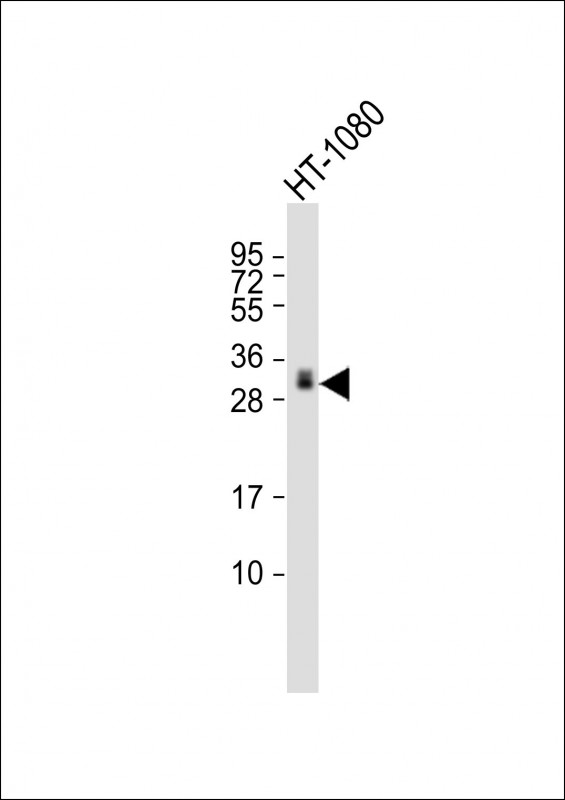GDF15 Antibody
Purified Mouse Monoclonal Antibody (Mab)
- 产品详情
- 实验流程
- 背景知识
Application
| WB, E |
|---|---|
| Primary Accession | Q99988 |
| Reactivity | Human |
| Predicted | Human |
| Host | Mouse |
| Clonality | monoclonal |
| Isotype | IgG1,κ |
| Clone Names | 2182CT228.18.8 |
| Calculated MW | 34140 Da |
| Gene ID | 9518 |
|---|---|
| Other Names | Growth/differentiation factor 15, GDF-15, Macrophage inhibitory cytokine 1, MIC-1, NSAID-activated gene 1 protein, NAG-1, NSAID-regulated gene 1 protein, NRG-1, Placental TGF-beta, Placental bone morphogenetic protein, Prostate differentiation factor, GDF15 (HGNC:30142) |
| Target/Specificity | This GDF15 antibody is generated from a mouse immunized with a recombinant protein from the human GDF15. |
| Dilution | WB~~1:4000 E~~Use at an assay dependent concentration. |
| Format | Purified monoclonal antibody supplied in PBS with 0.09% (W/V) sodium azide. This antibody is purified through a protein G column, followed by dialysis against PBS. |
| Storage | Maintain refrigerated at 2-8°C for up to 2 weeks. For long term storage store at -20°C in small aliquots to prevent freeze-thaw cycles. |
| Precautions | GDF15 Antibody is for research use only and not for use in diagnostic or therapeutic procedures. |
| Name | GDF15 {ECO:0000303|PubMed:23468844, ECO:0000312|HGNC:HGNC:30142} |
|---|---|
| Function | Hormone produced in response to various stresses to confer information about those stresses to the brain, and trigger an aversive response, characterized by nausea, vomiting, and/or loss of appetite (PubMed:23468844, PubMed:24971956, PubMed:28846097, PubMed:28846098, PubMed:28846099, PubMed:28953886, PubMed:29046435, PubMed:30639358, PubMed:31875646, PubMed:33589633, PubMed:38092039). The aversive response is both required to reduce continuing exposure to those stresses at the time of exposure and to promote avoidance behavior in the future (PubMed:30639358, PubMed:33589633, PubMed:38092039). Acts by binding to its receptor, GFRAL, activating GFRAL-expressing neurons localized in the area postrema and nucleus tractus solitarius of the brainstem (PubMed:28846097, PubMed:28846098, PubMed:28846099, PubMed:28953886, PubMed:31535977). It then triggers the activation of neurons localized within the parabrachial nucleus and central amygdala, which constitutes part of the 'emergency circuit' that shapes responses to stressful conditions (PubMed:28953886). The GDF15-GFRAL signal induces expression of genes involved in metabolism, such as lipid metabolism in adipose tissues (PubMed:31402172). Required for avoidance behavior in response to food allergens: induced downstream of mast cell activation to promote aversion and minimize harmful effects of exposure to noxious substances (By similarity). In addition to suppress appetite, also promotes weight loss by enhancing energy expenditure in muscle: acts by increasing calcium futile cycling in muscle (By similarity). Contributes to the effect of metformin, an anti-diabetic drug, on appetite reduction and weight loss: produced in the kidney in response to metformin treatment, thereby activating the GDF15-GFRAL response, leading to reduced appetite and weight (PubMed:31875646, PubMed:37060902). The contribution of GDF15 to weight loss following metformin treatment is however limited and subject to discussion (PubMed:36001956). Produced in response to anticancer drugs, such as camptothecin or cisplatin, promoting nausea, vomiting and contributing to malnutrition (By similarity). Overproduced in many cancers, promoting anorexia in cancer (cachexia) (PubMed:32661391). Responsible for the risk of nausea and vomiting during pregnancy: high levels of GDF15 during pregnancy, mostly originating from the fetus, are associated with increased nausea and vomiting (PubMed:38092039). Maternal sensitivity to nausea is probably determined by pre-pregnancy exposure to GDF15, women with naturally high level of GDF15 being less susceptible to nausea than women with low levels of GDF15 before pregnancy (PubMed:38092039). Promotes metabolic adaptation in response to systemic inflammation caused by bacterial and viral infections in order to promote tissue tolerance and prevent tissue damage (PubMed:31402172). Required for tissue tolerance in response to myocardial infarction by acting as an inhibitor of leukocyte integring activation, thereby protecting against cardiac rupture (By similarity). Inhibits growth hormone signaling on hepatocytes (By similarity). |
| Cellular Location | Secreted Note=Secreted in the plasma. |
| Tissue Location | Detected in plasma (at protein level) (PubMed:28572090, PubMed:29046435). Highly expressed in placenta, with lower levels in prostate and colon and some expression in kidney (PubMed:37060902, PubMed:9348093). |
For Research Use Only. Not For Use In Diagnostic Procedures.
Provided below are standard protocols that you may find useful for product applications.
BACKGROUND
Regulates food intake, energy expenditure and body weight in response to metabolic and toxin-induced stresses (PubMed:28953886, PubMed:28846097, PubMed:28846098, PubMed:28846099, PubMed:23468844, PubMed:29046435). Binds to its receptor, GFRAL, and activates GFRAL-expressing neurons localized in the area postrema and nucleus tractus solitarius of the brainstem (PubMed:28953886, PubMed:28846097, PubMed:28846098, PubMed:28846099). It then triggers the activation of neurons localized within the parabrachial nucleus and central amygdala, which contitutes part of the 'emergency circuit' that shapes feeding responses to stressful conditions (PubMed:28953886). On hepatocytes, inhibits growth hormone signaling (By similarity).
REFERENCES
Hromas R.,et al.Biochim. Biophys. Acta 1354:40-44(1997).
Yokoyama-Kobayashi M.,et al.J. Biochem. 122:622-626(1997).
Bootcov M.R.,et al.Proc. Natl. Acad. Sci. U.S.A. 94:11514-11519(1997).
Paralkar V.M.,et al.J. Biol. Chem. 273:13760-13767(1998).
Kalnine N.,et al.Submitted (MAY-2003) to the EMBL/GenBank/DDBJ databases.
终于等到您。ABCEPTA(百远生物)抗体产品。
点击下方“我要评价 ”按钮提交您的反馈信息,您的反馈和评价是我们最宝贵的财富之一,
我们将在1-3个工作日内处理您的反馈信息。
如有疑问,联系:0512-88856768 tech-china@abcepta.com.























 癌症的基本特征包括细胞增殖、血管生成、迁移、凋亡逃避机制和细胞永生等。找到癌症发生过程中这些通路的关键标记物和对应的抗体用于检测至关重要。
癌症的基本特征包括细胞增殖、血管生成、迁移、凋亡逃避机制和细胞永生等。找到癌症发生过程中这些通路的关键标记物和对应的抗体用于检测至关重要。 为您推荐一个泛素化位点预测神器——泛素化分析工具,可以为您的蛋白的泛素化位点作出预测和评分。
为您推荐一个泛素化位点预测神器——泛素化分析工具,可以为您的蛋白的泛素化位点作出预测和评分。 细胞自噬受体图形绘图工具为你的蛋白的细胞受体结合位点作出预测和评分,识别结合到自噬通路中的蛋白是非常重要的,便于让我们理解自噬在正常生理、病理过程中的作用,如发育、细胞分化、神经退化性疾病、压力条件下、感染和癌症。
细胞自噬受体图形绘图工具为你的蛋白的细胞受体结合位点作出预测和评分,识别结合到自噬通路中的蛋白是非常重要的,便于让我们理解自噬在正常生理、病理过程中的作用,如发育、细胞分化、神经退化性疾病、压力条件下、感染和癌症。






